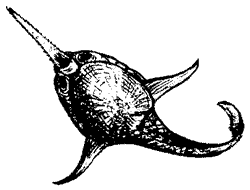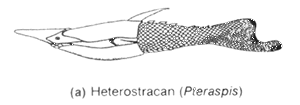
Doryaspis, a protopteraspid from the Lochkovian to Pragian of northern Euromerica. Length 15 cm. Graphic from Faktaside om fossile urfisk fra Norge, © 1998 Paleontologisk Museum,- University of Oslo.

| Pteraspidomorphi | ||
| The Vertebrates | Pteraspidiformes |
| Vertebrates Home | Vertebrate | Vertebrate |
Abbreviated Dendrogram
Vertebrata
├─Conodonta
└─┬─Thelodonti
│
└─Pteraspidomorphi
├─Arandaspida
└─Heterostracomorphi
├─Astraspidae
└─Heterostraci
├─Cyathaspidiformes
│ ├─Cyathaspidida
│ └─Amphiaspidida
└─Pteraspidiformes
├─Anchipteraspididae
└─Pteraspidida
├─Protopteraspididae
└─Pteraspidina
├─Pteraspididae
└─Protaspidoidea
├─Protaspididae
└─Psammosteida
├─Drepanaspis
└─Psammosteidae |
Contents
Overview |
The Pteraspidiformes occur first in the Late Silurian but become much more diverse during the Early Devonian. They include streamlined spiny forms like Pteraspis and Doryaspis , and flattened bottom-dwellers, some of which grew to large size. All pteraspidiforms are characterized, among other features, by a dorsal shield made up of several independent plates. In this they differed from their cousins the Cyathaspidiformes, in which there was the tendency for all the plates to fuse into a single unit.
At least five families of pteraspidiforms can be distinguished. The Psammosteida will be covered on the next page. The others are:
The Anchipteraspididae (Anchipteraspis, Ulutitaspis, Rhachiaspis) are small primitive forms from the Late Silurian and Early Devonian of the Canadian Arctic (northwest Euramerica), resembling the cyathaspidiforms in possessing only a single fused branchio- cornual plate, and lacking the separate plates that define all other pteraspidiforms. They are close to the ancestral stock from which other pteraspidiforms evolved.
 |
|
Doryaspis, a protopteraspid from the Lochkovian to Pragian of northern Euromerica. Length 15 cm. Graphic from Faktaside om fossile urfisk fra Norge, © 1998 Paleontologisk Museum,- University of Oslo. |
 |
| Pteraspis, a pteraspidid from the Pragian of Southeast Euromerica. Length 20 cm. |
The Protopteraspididae are similar to the Pteraspididae. Some protopteraspidids, such as Doryaspis (also called Lyktaspis) have a strange snout or rostrum (the elongated median oral plate). There were bony spines set along its length, like the "saw" of a modern sawfish, except that the mouth is located above, rather than below, the rostrum. This purpose of this strange appendage is not clear. It may have had a hydrodynamic function, since the shape of Doryaspis suggests it was an active swimmer, probably feeding on plankton. Or it may have been used to stir up the bottom mud or sand, to find crustacea or other tiny invertebrates.
Doryaspis also had unusually long, lateral keels growing from the back of the head shield. Their leading edges were also armed with tooth- like spines. It is suggested that these may have acted as hydrofoils, and along with the rostrum and downturned tail, elevated the front of the body during swimming.
The Pteraspididae are quite similar in overall morphology to the Protopteraspididae, but are distinguished by a supraorbital canal passing through the pineal plate (a feature shared in common with the Protaspididae and Psammosteida). It is likely therefore that the Pteraspididae evolved from the Protopteraspididae, rather than the reverse. Like the Protopteraspididae they were streamlined swimmers, and one genus, Rhinopteraspis resembles Doryaspis in having a very long rostrum and spinal plate although in this case located in the normal position, above the mouth).

|
| Convergent evolution in Early Devonian jawless fishes. The head- shields of ( 1) Doryaspis, a heterostracan; (2) Asiaspis, a galeaspid; (3) Boreaspis, an osteostracan; and ( 4) Pituriaspis, a pituriaspid. |
In Pteraspis, the most representative member of the family, the rostrum is of more normal proportions. The Pteraspids became very numerous and diverse during the Late Silurian and Early Devonian. Although lacking paired fins, the pteraspids were probably powerful swimmers. Stability was provided by the wing-like outgrowths from the back of the head shield. A large spine over the back acted as a kind of dorsal fin while 2 rigid 'wings' or keels functioned as pectoral hydrofoils. The long, flexible tail was also hydrodynamic, with the lower lobe elongated to provide lift at the front of the body during swimming. Additional lift was provided by the elongated snout, which was drawn out into a bladelike 'rostrum', below which the mouth opened. It is thought that the pteraspids and protopteraspids fed in mid-water or near the surface of the sea, among the shoals of planktonic, shrimp- like crustaceans.
As with the Protopteraspididae, the rostrum may have served a dual purpose, both hydrodynamic and used to probe the mud and sediment for small organisms. Significantly, the existence of an elongated rostral spine, and sometimes side spines or wings or cornua as well, seems to have been a recurring theme among the early Devonian ostracoderms, as indicated in the following diagram, which shows that some representatives of each of the four major armoured classes developed this feature.
The Protaspididae are early Devonian transitional forms between the Pteraspididae and Psammosteida. The head shield has already become broad and flattened, indicating a shift to a benthic (bottom-living) existence. MAK
Late Silurian to Late Devonian.
Characters: separate orbital, pineal and rostral plates; single median dorsal spinal plate present; separate branchial and cornual plates; dermal ornamentation of concentric, serrated dentine ridges.
Links: Pteraspidiformes, Class Pteraspidomorphi, Heterostraci. ATW020510.
Anchipteraspididae: Anchipteraspis, Ulutitaspis, Rhachiaspis
Range: Late Silurian to Early Devonian of North America
Phylogeny: Pteraspidiformes: Pteraspidida + *.
Characters: small; resemble cyathaspidiforms in single, fused branchio- cornual plate. ATW020510.
Range: Early Devonian to Late Devonian.
Phylogeny: Pteraspidiformes: Anchipteraspididae + *: Protopteraspididae + Pteraspidina.
Characters: separate cornual plates, dorsal shield made up of several separate units.
References: Janvier (1996). ATW020510.
Protopteraspididae: Doryaspis, Protopteraspis.
Range: Early Devonian to Middle Devonian of North America, Spitzbergen & Russia (Siberia?).
Phylogeny: Pteraspidida: Pteraspidina + *.
Characters:
Links: IGCP, Heterostraci; examples of heterostracans. ATW020510.
Range: Early Devonian to Late Devonian.
Phylogeny: Pteraspidida: Protopteraspididae + *.
Characters: pineal sensory-line canal passes through pineal plate.
Image: Pteraspis: Evol.Page to Print: Clado Pic. Resources. ATW020510.
Pteraspididae: Errivaspis, Pteraspis, Rhinopteraspis, Unarkaspis.
 Characters:supraorbital canal passing through the pineal plate; more separate plates than Cyathaspidida; lateral growth rings; lateral and dorsal spines and keels, smaller body scales, cornua and rostra.
Characters:supraorbital canal passing through the pineal plate; more separate plates than Cyathaspidida; lateral growth rings; lateral and dorsal spines and keels, smaller body scales, cornua and rostra.
Heterostraci; Pteraspididae; Various Illustrations; Pteraspis rostrata; Siluriano Italian); ¾î·ù>ÆäÅ׶ó½ºÇǽº Korean); Fish Replicas - Hanman's Fossils & Minerals; Presse service hos Grafikhuset (Danish -- click on picture for zip file of enormous life image in .tif format).
Image: © 1999 ENSI (Evolution & the Nature of Science Institutes). ATW020510.
$ enlarged, flattened branchial plates; $ reduced cornual plates.
ATW010815.
Early Devonian of North America.
Protaspidoidea: Psammosteida + *.
Head shield round and flat; without fragmented dorsal shield areas of psammosteids; concentric growth lines on head shield; cornual plates rudimentary or absent; cornual plate (when present) forms part of median margin of branchial opening [T64]; dorsal surface convex (benthonic?) [H73]; ventral surface broad & flat [H73].
Links: Pteraspidiformes; Heterostraci; Examples of heterostracans; Examples of heterostracans.
Halstead 1973) [H73], Tarlo (1964) [T64].
Note: Morphologically intermediate between the classic pteraspids and the psammosteids. ATW030530.
checked ATW060104